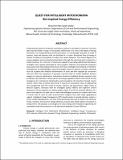Bio-Inspired Energy Dynamics
Author(s)
Datta, Shoumen
DownloadBio-Inspired Energy Dynamics (678.9Kb)
Metadata
Show full item recordAbstract
Energy policies based on empirical assumptions without a foundation in granular real-time data may be limited in scope. It may sputter ineffectively in its role as the engine of energy economics. For energy efficiency and conservation, it is increasingly necessary to invest in systems, tools and practices that can facilitate bi- or multi- directional flow of energy to control or balance consumption to reduce the carbon footprint. The central dogma of an energy oligopoly and uni-directional distribution through the electricity grid is poised for a radical overhaul. An “internet” of electricity capable of executing differential distribution strategies from capacity generated by micro-supplier networks and electricity producers may evolve from the proposed Smart Grid. The future intelligent Grid (inGrid) is imminent. Development of methodologies using technologies based on rigorous scientific standards must be coupled with effective dissemination of tools and then adopted by consumers who will allow the acquisition of granular real-time data to enable feedback decision support or resource optimization. Automation driven by intelligent decision systems is key to efficacy. We advocate a closer look at the energy regulation within cells and call for the emergence of a mechanical mitochondria and convergence of innovation through service science, which may co-evolve with inGrid. It may be an amorphous nexus of engineering and management with the needs of society, industry and government. Higher levels of decision support, necessary both for strategists (policy makers) and engineers (inGrid operators) may be impotent or without global impact if we fail to promote diffusion of a grass-roots approach to seed one or more methodologies necessary to acquire data from a critical mass of users (in each environmental category from each major geographical region). Intelligent Energy Transparency (iET) should evolve to provide decision makers a secure mobile dashboard for real-time multi-directional flow and to balance the demand. Finally, however, the future of energy efficiency may be quite bleak without innovation in energy forms. We propose a convergence of solar energy with metabolic engineering for renewable liquid fuel production in the petroleum-depleted (?) post-2050 era.
Description
Changing the energy form factor (in certain instances) may be helpful. This working paper suggests the potential to change the "physics" of energy to "chemistry" in order to better utilize solar power.
Date issued
2010-03-27Department
Massachusetts Institute of Technology. Auto-ID LaboratoryKeywords
Intelligent Grid, Mechanical Mitochondria, Intelligent Energy Transparency (iET), Internet of Electricity, Dynamic Pricing, Metabolic Engineering, Synthetic Chlorophyll
Collections
The following license files are associated with this item: